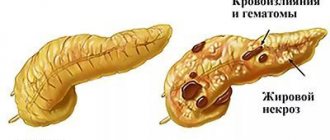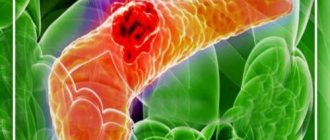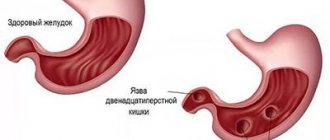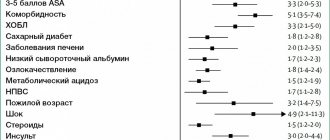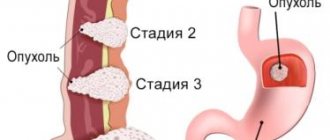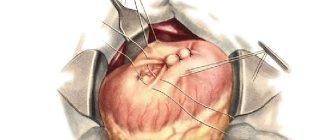A gastric ulcer is a defect in the mucous membrane and underlying tissues of an organ, the appearance of which is characteristic of an exacerbation of a gastric ulcer or the action of a number of provoking factors.
The pathology is manifested by pain in the epigastric region, a feeling of heartburn, nausea, and vomiting. The condition is dangerous for humans due to its complications, including bleeding, perforation of the stomach wall with peritonitis symptoms, cicatricial narrowing of the pyloric region, and malignant degeneration of cells in the damaged area.
Conservative treatment of gastric ulcers includes following a diet, taking antibiotics and drugs that reduce the aggressive effect of enzymes on the organ wall. If complications occur, surgical intervention is required.
Causes
Gastric and duodenal ulcers develop in conditions of an imbalance of factors of aggression and protection of the mucous membrane due to improper neurohumoral regulation, disorders of blood supply and nutrition of organ tissues, drug or toxic damage.
The following factors may contribute to this:
- smoking;
- frequent consumption of alcoholic and energy drinks, coffee;
- chronic overwork, acute or prolonged stress;
- serious illnesses and injuries;
- unhealthy diet with a lot of refined foods, fast food, spicy, sour, salty or pickled, excessively cold or hot foods;
- lack of proper sleep;
- taking drugs based on digitalis, from the group of NSAIDs, steroid hormones, sulfonamides, potassium chloride, anticoagulants, nitrofurans;
- genetic predisposition;
- presence of H.pilori in the stomach;
- hyperparathyroidism;
- hormonal age-related changes;
- chronic gastritis;
- diabetes.
Antipyretic drugs part 2
Home Medical Encyclopedia Medicines Analgesic (painkillers) and non-steroidal anti-inflammatory drugs
PARACETAMOL (Paracetamolum)
Synonyms: Panadol, Panadol soluble, Panadol junior, Acetofen, Opradol, Ushamol, Abesanil, Acetalgin, Acetaminophen, Acetaminophenol, Actazol, Algotoropil, Aminophen, Apagan, Apamide, Biocetamol, Celifen, Cetadol, Dapirex, Dolamin, Efferoglan, Erocetamol, Febridol, Febrinol, Nasprin, Pacimol, Pyrinazine, Tralgon, Valadol, Valorin, Acelifen, Acemol, Alvedon, Amphenol, Apanol, Cetanil, Hemcetafen, Datril, Dexamol, Dimindol, Dolanex, Dolipram, Efferalgan, Febrinil, Fendon, Metamol, Minoset, Mialgin, Napamol, Naprinol, Nizacetol, Rolocin, Tempramol, Thilemin, Tylenol, Valgesik, Volpan, Vinadol, AkamolTeva, Bindard, Dafalgan, Deminofen, Mexalen, Nepa, Paramol, Piremol, Tylenol, Ifimol, Aminodol, Febricet, Calpol, etc.
Pharmachologic effect. Paracetamol is chemically close to phenacetin. In terms of analgesic activity, paracetamol does not differ significantly from phenacetin; like phenacetin, it has weak anti-inflammatory activity. The main advantages of paracetamol are less toxicity, less ability to cause the formation of methemoglobin (a derivative of hemoglobin that is unable to carry oxygen).
It has an analgesic, antipyretic and weak anti-inflammatory effect, which is associated with the effect of the drug on the thermoregulation center in the hypothalamus (division of the diencephalon) and the ability
inhibit (suppress) the synthesis of prostaglandins. (Prostaglandins are biologically active substances produced in the body. Their role in the body is extremely multifaceted, in particular, they are responsible for the appearance of pain and swelling at the site of inflammation.)
Indications for use. Pain syndrome of low and medium intensity of various genesis (origin) - headache, migraine, toothache, neuralgia (pain spreading along the nerve), myalgia (muscle pain), menalgia (menstrual pain); pain from injuries, burns. Fever (sharp increase in body temperature) in infectious and inflammatory diseases.
Method of administration and dose. Adults and adolescents weighing more than 60 kg are prescribed in a single dose of 0.5 g. The maximum single dose is 1.0 g. The frequency of administration is up to 4 times a day. The maximum daily dose is 4.0 g. Tablets should be taken with a small amount of liquid. The maximum duration of treatment is 5-7 days. When using the drug, Panadol Soluble tablets should be dissolved in water before use.
Rectal suppositories are prescribed to adults and adolescents weighing more than 60 kg in a single dose of 0.25-0.5 g. The maximum daily dose is 1.0 g. The frequency of administration is up to 4 times a day. The maximum daily dose is 4.0 g.
Powder in sachets (Panadol Junior) is prescribed to children aged 6 to 12 years, 2-4 teaspoons of suspension (10-20 ml) or 1-2 sachets of powder up to 4 times a day. The intervals between doses of the drug must be at least 4 hours. Before use, the contents of the sachet must be dissolved in a glass of water. It is not advisable to use the drug for more than 3 days.
When using paracetamol, it is necessary to monitor the peripheral blood picture and the functional state of the liver.
Side effect. Possible nausea, pain in the epigastrium (the area of the abdomen located directly below the convergence of the costal arches and sternum); allergic reactions in the form of skin rash, itching, urticaria, Quincke's edema. Rarely - anemia (decrease in hemoglobin content in the blood), thrombocytopenia (decrease in the number of platelets in the blood), methemoglobinemia (increased content in the blood of methemoglobin - a hemoglobin derivative that is not capable of carrying oxygen). With long-term use in high doses, hepatotoxic (liver-damaging) effects are possible.
With long-term use, especially in large doses, paracetamol can have a nephrotoxic (kidney damaging) effect.
Contraindications. Severe liver and/or kidney dysfunction; deficiency of the enzyme glucose-6-phosphate dehydrogenase; blood diseases; hypersensitivity to paracetamol. Prescribe with caution to patients with impaired liver and kidney function, with benign hyperbilirubinemia (increased bilirubin in the blood), during pregnancy and lactation, as well as elderly patients. When administered simultaneously with paracetamol, barbiturates, antiepileptic drugs, rifampicin, and alcohol significantly increase the risk of hepatotoxicity.
Release form. Tablets of 0.325 and 0.5 g. Capsules of 0.5 g. Oral solution. Syrup (5 ml - 0.2 g). Powder. Suspension (5 ml -0.12 g) in vials. Rectal suppositories 0.125; 0.25; 0.5 and 1.0 g. Rectal suppositories 0.08; 0.17 and 0.35 g. Instant tablets, 0.5 g each. Powder in bags. Solution for injection (0.15 g in 1 ml) in ampoules of 5 ml. Syrup (0.025 g in 1 ml).
Storage conditions. List B. In a well-closed container, protected from light; tablets - in a place protected from light.
Gevadal
Pharmachologic effect. A combination drug containing paracetamol, propyphenazone and caffeine. It has an analgesic (pain-relieving) and antipyretic effect. Has some psychostimulating effect.
Indications for use. Headache, muscle pain, toothache, neuralgia (pain spreading along the nerve), acute respiratory (respiratory system) diseases.
Method of administration and dose. A single dose for pain is 1-2 tablets. The maximum daily dose is 3-6 tablets. Take during or after meals.
Side effect. Nausea, vomiting. Possible ulcerogenic (ulcer-causing) effect. Dizziness, increased bleeding, allergic reactions.
Contraindications. Hypersensitivity to the components of the drug. Hemorrhagic diathesis (increased bleeding), surgical interventions accompanied by bleeding, peptic ulcer of the stomach and duodenum, bronchial asthma, gout.
You should not drink alcohol while using the drug. The use of the drug during pregnancy and breastfeeding is allowed only for a short time.
Release form. Tablets containing 0.25 g of paracetamol and propyphenazone and 0.05 g of caffeine, in a package of 10 pieces.
Storage conditions. In a dry place, protected from light.
KAFFETIN
Pharmachologic effect. A combined drug whose effect is determined by the properties of its constituent components. Paracetamol and propyphenazone have analgesic (pain reliever), antipyretic and anti-inflammatory effects. Caffeine has a psychostimulating effect and dilates blood vessels in the brain. Codeine phosphate has antitussive and some analgesic activity of central origin (origin).
Indications for use. Headache, toothache, migraine, neuralgia (pain spreading along the nerve), sciatica (pain along the sciatic nerve), myalgia (muscle pain), pain due to dysmenorrhea (menstrual disorder), colds, flu, etc. .
Method of administration and dose. Adults are prescribed 1 tablet 3-4 times a day. For severe pain, it is recommended to use 2 tablets at once. Children are prescribed depending on age: 2-5 years - 1/3 tablet 1-3 times a day; 5-10 years - 1/2 tablet 1-3 times a day; over 10 years - 1 tablet 1-3 times a day.
Side effect. Very rarely and with long-term use - leukopenia (decrease in the level of leukocytes in the blood), agranulocytosis (sharp decrease in the number of granulocytes in the blood).
Contraindications. Hypersensitivity to the components of the drug.
Release form. Tablets in packages of 10, 20, 100 and 500 pieces. 1 tablet contains paracetamol 0.25 g, propyphenazone 0.21 g, caffeine 0.05 g, codeine phosphate 0.01 g.
Storage conditions. List B. In a dry place.
MEXAVIT
Synonyms: Citripan, Citripanchek, Efferalgan with vitamin C, Paracetamol + ascorbic acid.
Pharmachologic effect. A combined drug whose effect is determined by the properties of its constituent components. Paracetamol has an analgesic (pain reliever), antipyretic effect, and has mild anti-inflammatory activity. Ascorbic acid (vitamin C) in the body is involved in the regulation of oxidative-inflammatory processes, carbohydrate metabolism, blood clotting, tissue regeneration (repair); in the formation of steroid hormones, the synthesis of collagen and procollagen and the normalization of capillary permeability (the smallest vessels). Increases the body's resistance to infections by stimulating the immune system (the body's defenses) and preventing the spread of pathogenic microbes in tissues. The combination of paracetamol and ascorbic acid improves the tolerability of paracetamol and prolongs (extends) its action.
Considering the low toxicity of mexavit, it can be used in patients with moderately severe pathological changes in the gastrointestinal tract.
Indications for use. Fever (sharp increase in body temperature) in infectious and inflammatory diseases; pain syndrome of various origins (causes) of mild and moderate severity: with headaches, neuralgia (pain spreading along the nerve), myalgia (muscle pain), arthralgia (joint pain), algodismenorrhea (painful menstruation), etc.
Method of administration and dose. Before use, the tablet is dissolved in 1/2-1 glass of boiled water.
Typically, adults and adolescent children (weighing more than 50 kg) are prescribed the drug in a single dose of 1 tablet. The maximum daily dose is 4 tablets.
For children aged 6 to 12 years, Meksavit is prescribed 1/2 tablet per dose. The maximum daily dose is 2 tablets.
Taking into account the patient’s body weight, the drug can be prescribed at 0.01-0.015 g/kg up to 4 times a day.
In the form of granules containing 500 mg of paracetamol and 20 mg of ascorbic acid, the drug is prescribed to adults and children over 12 years of age, 1 sachet (5 g) 4-6 times a day. Before use, dissolve the contents of the sachet in 1 glass of hot water, stir and drink. Daily dose - 6 sachets.
The drug in the form of granules containing paracetamol 120 mg and ascorbic acid 10 mg is prescribed to children from 2 to 6 years old, 1-2 sachets (5 g) per 50 ml of hot water; The highest daily dose is 6 sachets. Children from 6 to 12 years old - 2 sachets per 100 ml of hot water; The highest daily dose is 10 sachets.
The duration of the course of treatment should not exceed 10 days.
In patients with impaired renal or liver function, the daily dose is reduced by reducing the single dose and/or the number of doses of the drug.
If abdominal pain occurs during treatment with Mexavit, the drug should be discontinued until consulting a doctor.
Side effect. Rarely - irritation of the gastrointestinal mucosa; very rarely (with long-term use) - liver dysfunction. Thrombocytopenic purpura (increased bleeding due to a decrease in the level of platelets in the blood), hemolytic anemia (decreased hemoglobin levels due to increased breakdown of red blood cells in the blood), agranulocytosis (a sharp decrease in the number of granulocytes in the blood). In isolated cases, especially with long-term use in large doses, there is a nephrotoxic (kidney-damaging) effect. Rarely - exanthema (general name for skin rash), angioedema (allergic edema). In some cases, the development of bronchospasm (sharp narrowing of the lumen of the bronchi). Rarely - fever.
Contraindications. Severe renal or liver dysfunction; established deficiency of the enzyme glucose-phosphate dehydrogenase; alcohol abuse; hypersensitivity to any of the components of the drug.
The drug is prescribed with caution to patients with impaired renal and liver function, with increased sensitivity to non-steroidal anti-inflammatory drugs; patients with bronchial asthma. During periods of pregnancy and breastfeeding, it is prescribed only according to strict indications under medical supervision; A single dose is preferred. Children under 6 years of age are prescribed Mexavit only after consultation with a doctor (if the drug is prescribed, the child must be provided with plenty of fluids).
Release form. Effervescent tablets in packs of 10 and 20 pieces. Composition of 1 tablet: paracetamol -0.5 g, ascorbic acid - 0.2 g; other ingredients (sodium saccharin -0.015 g; lactose -0.105 g, sorbitol -0.105 g).
Effervescent tablets in packs of 10 and 20 pieces. 1 tablet contains paracetamol 330 mg and ascorbic acid 200 mg (efferalgan with vitamin C).
Granules for the preparation of a solution for oral administration in bags of 10 pieces. 1 packet contains 500 mg of paracetamol and 20 mg of ascorbic acid (citripan).
Granules for the preparation of a solution for oral administration in bags of 10 pieces. 1 packet contains 120 mg of paracetamol and 10 mg of ascorbic acid (citripanchek).
Storage conditions. In a dry place at a temperature not exceeding +25 °C. Myolgin
Pharmachologic effect. A combined drug whose effect is determined by the properties of its constituent components. Paracetamol has an analgesic effect. Chlorzoxazone relaxes skeletal muscles, relieves (relieves) skeletal muscle spasms of various etiologies (causes). It appears to act at the level of the spinal cord. When taking miolgin, there is a rapid reduction in pain and restoration of muscle contractility.
Indications for use. Treatment of acute spastic conditions of muscles observed during sprains, injuries, spondyloarthrosis (disease of the spine), torticollis. Lumbago (paroxysmal intense pain in the lumbar region). Cervical radicular syndrome. Headaches associated with a spastic state of the muscles of the head and neck.
Method of administration and dose. 1-2 capsules 3 times a day.
Side effect. Possible dizziness, nausea, insomnia, dysfunction of the digestive system, change in urine color.
Contraindications. Pregnancy, hypersensitivity to the drug.
Release form. Capsules containing 0.3 g of paracetamol and 0.25 g of chlorzoxazone.
Storage conditions. List B. In a dry place.
PANADEIN
Pharmachologic effect. A combined drug that has an analgesic (pain-relieving) effect with central and peripheral effects.
Indications for use. Migraine, headache, rheumatic diseases, neuralgia (pain spreading along the nerve), arthritis (inflammation of the joint), periodic toothache, colds, flu.
Method of administration and dose. Adults are prescribed 1-2 tablets every 4 hours. The maximum daily dose is
8 tablets. Children aged 7 to 12 years - 1/2-1 tablet every 4 hours. The maximum daily dose is 4 tablets.
Taking the drug for more than three days must be done under medical supervision.
Side effect. Allergic reactions in the form of skin rash, angioedema, urticaria.
Contraindications. Hypersensitivity to any of the components of the drug. The drug is not prescribed to children under 7 years of age.
Release form. Tablets containing 0.5 g of paracetamol and 0.008 g of codeine phosphate, in a package of 12 pieces.
Storage conditions. List B. In a dry place.
PANADOL EXTRA (Panadolextra)
Synonyms: Darval.
Pharmachologic effect. A combined drug whose effect is determined by the properties of its constituent components. It has an analgesic (pain reliever), antipyretic and mild anti-inflammatory effect.
Indications for use. Headache, migraine, pain in the skeletal bones and muscles, neuralgia (pain spreading along the nerve), toothache, flu, colds, fever.
Method of administration and dose. Adults are prescribed 2 tablets 4 times a day with an interval of at least 4 hours. The maximum daily dose is 8 tablets.
Excessive intake of coffee or tea at the same time as the drug may cause overdose symptoms.
Side effect. Allergic reactions in the form of skin rash, angioedema, urticaria.
Contraindications. The drug is not prescribed to children under 12 years of age.
Release form. Tablets containing 0.5 g of paracetamol and 0.065 g of caffeine.
Storage conditions. List B. In a dry place.
Plivalgin
Pharmachologic effect. A combined drug whose effect is determined by the properties of its constituent components. It has a pronounced analgesic (pain-relieving) effect, as well as an antipyretic and weak sedative (calming) effect.
Indications for use. Headache, migraine, glaucoma (increased intraocular pressure), toothache, neuralgia (pain along the nerve), neuritis (inflammation of the nerve), polyneuritis (multiple inflammation of the nerves), sciatica (pain along the sciatic nerve), myalgia (pain in the muscles), arthralgia (joint pain), dysmenorrhea (menstrual disorder), colds, flu.
Method of administration and dose. Adults are prescribed 2 tablets per dose; if necessary, up to 6 tablets per day (in 3-4 doses). Children - 1/4-1/2 tablets 1-4 times a day.
Side effect. With repeated use, especially in higher dosages, drowsiness and fatigue may occur.
Contraindications. Hypersensitivity to the components of the drug, porphyria (disorder of porphyrin metabolism).
Use the drug with caution during pregnancy and breastfeeding. The drug can affect the psychophysical abilities of the body, weakening attention and slowing down responses, especially when used with alcoholic beverages or in combination with drugs that depress the central nervous system.
Release form. Tablets in a package of 100 pieces. 1 tablet contains: paracetamol -0.21 g; propyphenazone - 0.21 g; caffeine - 0.05 g; phenobarbital - 0.025 g; codeine phosphate -0.01 g.
Storage conditions. List B. In a dry place.
REMIDON
Pharmachologic effect. A combined drug whose effect is determined by the properties of its constituent components. It has a pronounced analgesic, antipyretic, as well as anti-inflammatory and some antispasmodic (relieving spasms) effect. The drug also has a psychostimulating effect.
Indications for use. Headache, migraine. Neuralgia (pain spreading along the nerve), myositis (muscle inflammation), arthritis (joint inflammation). Biliary, renal, intestinal colic. Algomenorrhea (painful menstruation). Post-traumatic pain. Colds.
Method of administration and dose. Prescribe 1-2 tablets 3 times a day for 3-5 days.
Side effect. Possible skin rash, Quincke's edema (allergic edema); in rare cases - anaphylactic shock (immediate allergic reaction). Isolated cases of anemia (decreased hemoglobin content in the blood), thrombocytopenia (decreased number of platelets in the blood), and methemoglobinemia (increased blood levels of methemoglobin, a hemoglobin derivative that is not capable of carrying oxygen), have been described.
Contraindications. Hypersensitivity to any of the components of the drug. Severe renal and/or liver failure. Deficiency of the enzyme glucose-6-phosphate dehydrogenase. Pregnancy. The drug is prescribed with caution to patients with impaired liver and kidney function.
Release form. Tablets containing paracetamol 0.2 g, analgin 0.2 g, caffeine 0.05 g, 20 pieces in a package.
Storage conditions. List B. In a dry place.
SARIDON
Synonyms: Paracetamol + propyphenazone + caffeine.
Pharmachologic effect. A combined drug whose effect is determined by the properties of its constituent components. Paracetamol has an analgesic (pain reliever), antipyretic and weak anti-inflammatory effect. This is due to its predominant influence on the thermoregulation center in the hypothalamus (in the diencephalon) and a less pronounced ability to inhibit the synthesis (suppress the formation in the body) of prostaglandins (biologically active substances produced in the body; their role in the body is extremely multifaceted, in particular, they responsible for the appearance of pain and swelling at the site of inflammation). Propyphenazone has an analgesic effect. Caffeine stimulates the respiratory and vasomotor centers, increases cerebral vascular tone, causes dilation of blood vessels in skeletal muscles, heart, kidneys, and reduces platelet aggregation (sticking together). Helps reduce drowsiness, increase mental and physical performance.
Indications for use. Pain syndrome of low and medium intensity of various origins (causes), including headache and toothache, migraine, algodismenorrhea (painful menstruation). Fever (sharp increase in body temperature) with colds and flu.
Method of administration and dose. Typically, adults are prescribed 1-2 tablets 1-3 times a day; children - 2-1 tablets 1-3 times a day. The tablets should be taken with
sufficient amount of liquid, preferably taken after meals. The duration of the course of treatment should not exceed 10 days.
Side effect. Possible nausea, vomiting, allergic skin reactions, dizziness, increased bleeding; erosive and ulcerative lesions (development of superficial defects of the mucous membrane) of the gastrointestinal tract.
Contraindications. Severe renal dysfunction, hereditary deficiency of the enzyme glucose-6-phosphate dehydrogenase, acute hepatoporphyria, hemorrhagic diathesis (increased bleeding), surgical interventions accompanied by bleeding, peptic ulcer of the stomach and duodenum, bronchial asthma, podarga, hypersensitivity to the components of the drug. The drug is not prescribed to young children. Avoid drinking alcohol while using the drug. During pregnancy and breastfeeding, the use of the drug is allowed only for a short time and according to strict indications. Use with caution for persons whose activities involve driving vehicles and operating machinery, as the drug may cause a decrease in the speed of motor reactions.
Release form. Tablets containing paracetamol 250 mg, propyphenazone 150 mg and caffeine 50 mg, in a package of 10 pieces.
Storage conditions. In a dry place, protected from light.
Solpadein
Pharmachologic effect. A combined drug whose effect is determined by the properties of its constituent components. Has an analgesic (pain-relieving) effect.
Indications for use. Migraine, headache, periodic toothache, neuralgia (pain spreading along the nerve), colds, flu, pharyngitis (inflammation of the pharynx), fever (sharp increase in body temperature), rheumatic diseases.
Method of administration and dose. Solpadeine should be dissolved in a glass of water before taking. Adults are prescribed 2 tablets every 4 hours. The maximum daily dose is 8 tablets. Children aged 7 to 12 years are prescribed 1/2-1 tablet no more than every 4 hours, the maximum daily dose is 4 tablets. Children should not take the drug for more than 3 days.
Side effect. Allergic reactions in the form of skin rash, angioedema, urticaria.
Contraindications. Hypersensitivity to any of the components of the drug. Solpadeine in tablets is not prescribed for children under 7 years of age, and in capsules for children under 12 years of age.
Release form. Tablets and capsules in a package of 12 pieces. 1 tablet (or capsule) contains 0.5 g of paracetamol, 0.008 g of codeine phosphate, 0.03 g of caffeine, as well as a special effervescent base with sorbitol.
Storage conditions. List B. In a dry place.
Paracetamol is also included in the drugs Askofen P, Bechem black currant, Hexapneumin, Ibuclnn, Influbene, Coldrex, Coldrex powders, Coldex Teva, Comtrex, Lanagesic, Tomapirin, Tomapirin S, Toff Plus, Fervex, Andrews Answer.
PHENACETIN (Phenacetinum)
Synonyms: Acetophenetidine, Fenetidine, Fenin, Acetophenidine, Acetparaphenalide, Fenedin, etc.
Pharmachologic effect. Antipyretic, analgesic and anti-inflammatory agent.
Indications for use. For headaches, migraines, myalgia (muscle pain), arthritis (joint inflammation), febrile conditions (high body temperature).
Method of administration and dose. 0.25-0.5 g 2-3 times a day.
The highest single dose is 0.5 g, the daily dose is 1.5 g.
Side effect. Allergic reactions are possible; large doses can cause methemoglobinemia (increased levels of methemoglobin in the blood - a derivative of hemoglobin that is not capable of carrying oxygen
Contraindications. Individual intolerance to the drug, impaired renal function.
Release form. Powder; tablets of 0.25 g in a package of 6 pieces.
Storage conditions. List B. In a place protected from light.
Phenacetin is also included in the combination drugs Antastman, Sedalgin, Ankofen tablets, Askofen tablets, Coficil tablets, Novomigrofen tablets, Pyrafen tablets, Pircofen tablets, Theophedrine tablets, Theophedrine N tablets ", tablets "citramon", tomapirin, phenalgin.
| print version | This information is not a guide to self-treatment. A doctor's consultation is required. |
Classification
According to location, ulcerative defects are divided into the following types:
- gastric;
- localized in the bulb or postbulbar part of the duodenum;
- combined ulcers with simultaneous damage to the stomach and intestines.
Causes of stomach ulcers include:
- stress, including Curling's ulcer with extensive thermal burns, Cushing's ulcer with severe brain damage, post-infarction, post-traumatic and other types of ulcers;
- medicinal;
- with hyperparathyroidism;
- toxic;
- allergic.
Peptic ulcer disease is often associated with Helicobacter pylori infection, but can occur without it.
In accordance with the course of the disease, the ulcer is classified into the stages of exacerbation, scarring, and remission.
General recommendations
- If the temperature is low-grade and is a symptom of a stomach ulcer, efforts should be directed toward treating the disease.
- If there are signs of a cold (runny nose, cough, throat congestion), it is better not to lower the temperature below 38.5C, giving the body the opportunity to cope with the infection on its own. Plenty of warm drinks are necessary. With a further increase in temperature, it is allowed to use folk remedies: rubdowns and decoctions of medicinal plants (with caution).
- If the temperature rises against the background of symptoms of complications of the ulcer (vomiting, persistent severe pain, pallor, etc.), you need to call an ambulance.
Symptoms
Manifestations of the disease depend on the location and depth of organ damage, the presence of complications, and the functioning of the digestive tract.
Signs of a stomach ulcer include:
- Pain. Localized in the epigastric or epigastric region, more pronounced on the left side. In children, it may occupy a central position and predominate near the navel. The nature of the pain varies: aching, burning, pulling, pressing, boring. Their duration in most cases is about one and a half or two hours. The onset of pain with a stomach ulcer is often associated with food intake and is noted in the interval from half an hour to an hour after eating. If the pyloric organ or duodenum is damaged, discomfort occurs later, on an empty stomach, at night. In the latter case, food alleviates the condition.
- Dyspeptic phenomena. These include belching, heartburn, a feeling of heaviness and fullness after eating, flatulence, nausea, and vomiting, which brings temporary relief. Also, exacerbations of gastric ulcers are characterized by stool disturbances. Most often they are accompanied by constipation and “sheep” feces of a dense consistency, but diarrhea can also develop.
- Decreased appetite. The patient often limits the volume of food portions due to a feeling of early satiety and discomfort that occurs after eating.
- Mental disorders. Emotional lability and increased fatigue, anxiety or depression may develop.
If a stomach ulcer develops against the background of gastritis, then initially there is bad breath, a white coating on the surface of the tongue, and a change in taste perception.
In young patients, painful sensations are more pronounced. People in the older age group suffer predominantly from dyspeptic disorders and have a higher risk of developing complications.
With a perforated gastric ulcer, during perforation of the organ wall, a pronounced “dagger” pain appears, which can cause a state of shock in the patient and disorientation, and often loss of consciousness. Characteristic symptoms of bleeding from a stomach ulcer are vomiting, which looks like coffee grounds, the appearance of tarry black stools, general weakness, pale skin, and dizziness.
If fever is a symptom of a stomach ulcer
Often a stomach ulcer goes unnoticed. There are a number of typical symptoms for the disease:
- Regular pain (sharp and intense, dull, aching);
- Heartburn;
- Nausea, vomiting;
- Belching, bloating.
Temperature is not included in this list of characteristic signs; sometimes the disease is accompanied by an increase (from slight to 38.3C). An increase can be observed during exacerbations, after physical exertion, or be constant for a long time. There is no point in bringing down a low-grade fever that is present against the background of other symptoms of an ulcer. The main thing is to treat the underlying disease and strictly follow the doctor’s instructions.
Values above 38.3C are a sign of complications and a reason to call an ambulance.
Complications
Peptic ulcers and symptomatic ulcers of the stomach or duodenum carry a hidden danger due to the tendency to develop complications, which are often life-threatening for the patient. Among them are the following conditions:
- bleeding;
- perforation (formation of a through defect) of the organ wall;
- penetration of the ulcer (its spread to nearby organs);
- malignant degeneration of cells of the mucous membrane and underlying tissues of the stomach;
- cicatricial stenosis with narrowing or closing of the lumen of part of the organ.
What is temperature
If among the symptoms describing the patient’s condition is called “fever,” this means an increase in body temperature in comparison with the temperature in a healthy state. Usually we are talking about values above 37C (there are exceptions when the normal norm for a person is 35.6C, a value greater than 36C is considered elevated, you just need to take into account the individual characteristics of the body).
Temperatures above 38C are considered a protective mechanism in the fight against infections, during which the substances necessary for this fight are synthesized. The absence of such a reaction is a sign of weak immunity, when the body is unable to resist pathogens.
A temperature between 37C and 38C is called low-grade fever. It can persist for a long time, and often a person does not even notice the increase, discovering it by accident. The tests are normal, the disease is not diagnosed. Such a temperature is not normal; it indicates latent inflammation or a serious disease, for example, cancer. Temperature is a signal that requires attention.
With a peptic ulcer, temperature can be a symptom or indicate a complication.
Diagnostics
The diagnosis and treatment of uncomplicated gastric ulcers is carried out by a general practitioner or gastroenterologist.
In the event of bleeding or perforation of the organ wall, the patient, as a rule, ends up in a serious condition in a surgical hospital, where examination and surgical intervention are carried out. During the initial visit, the doctor clarifies the complaints, collects information about how long ago the symptoms appeared, the nature of the diet, and the presence of stomach diseases in close relatives. He assesses the patient’s condition and, by palpation, clarifies the boundaries of painful areas and their nature. In the future, laboratory and instrumental research methods are used.
If a stomach ulcer is suspected, the following tests are prescribed:
- Detection of Helicobacter pylori in the body. It is carried out by cytological examination of a gastric biopsy, detection of antibodies to the pathogen in the blood, using urease respiratory or antigen tests.
- A complete blood count to look for signs of an inflammatory reaction or bleeding.
- Blood chemistry. Determination of the level of CRP, liver enzymes.
- Fecal occult blood test.
- Determination of the level of gastrin-17 in the blood as a method for diagnosing pancreatic gastrinoma.
- Pepsinogens of the first and second types with calculation of their ratio.
- Serum iron concentration in blood.
Instrumental diagnosis of gastric ulcers includes:
- endoscopic examination of the hollow digestive organs with the collection of biomaterial from damaged areas for laboratory analysis;
- computed tomography of the abdominal organs, and if this is not possible, ultrasound examination of the abdominal organs or x-ray examination of the stomach and duodenum with preliminary introduction of an x-ray contrast agent into them;
- endogastric determination of the acidity of digestive juice.
Causes and mechanism of development of gastric and duodenal ulcers
To date, it has been proven that one of the causes of peptic ulcer disease is the opportunistic microorganism Helicobacter pylori. This statement is confirmed by the fact that in patients with gastric ulcers these bacteria are found in 80% of cases, and in people with duodenal ulcers in 90%. Peptic ulcer disease, like most other pathologies of the gastrointestinal tract, is a multifactorial disease. But there are also a number of predisposing factors for the development of peptic ulcers:
- genetic predisposition;
- poor nutrition (constant intake of spicy, coarse, sour and salty foods, snacks on the run, rare meals, addiction to fast food);
- excessive alcohol consumption;
- constant stress, or one-time, but strong;
- smoking;
- long-term use of certain medications (glucocorticoids, anti-inflammatory drugs);
- excessive physical work.
Treatment
All patients are advised to follow a diet, adjust their lifestyle, eliminate stress and other factors that can provoke an exacerbation of the disease.
Diet for stomach ulcers is recommended in fractional, small portions. Food should be at a comfortable temperature, not too hot or cold, with a minimum amount of salt. The preferred heat treatment options are steaming, stewing, boiling, and blanching. It is necessary to exclude fried, spicy, fatty, smoked foods, marinades, as well as foods that cause increased gas formation from the diet.
In case of peptic ulcer caused by Helicobacter pylori infection, eradication therapy drugs are used:
- proton pump inhibitors;
- antibiotics;
- bismuth-based medicines.
If, according to test results, the disease is not associated with Helicobacter pylori, then medications for stomach ulcers include drugs from the group of proton pump inhibitors and H2-histamine receptor blockers. They inhibit the production of hydrochloric acid by the fundic glands and reduce the effect of aggressive factors on organ tissue. To relieve the symptoms of exacerbation of gastric ulcers, tablets and suspensions of antacids, antispasmodics and prokinetics are used. Treatment of complications of ulceration primarily requires surgical intervention.
Exacerbation of gastric ulcer as a stage of the disease
Details Author: LDC Neuron Published: November 10, 2015
Gastric ulcer is a chronic disease that develops as a result of many causes that cause disruption of the neurohormonal regulation of gastric digestion and cause the formation of ulcers in the stomach, and often in the duodenum.
Peptic ulcer disease proceeds in waves, periods of exacerbation of the stomach ulcer alternate with light periods, when the number of complaints in the patient is reduced to a minimum, and the ulcer itself heals, disappears without a trace or leaves a scar.
With a mild form of peptic ulcer, exacerbations can occur once every 1–3 years, proceed quite easily, stop within a week, and the symptoms of the disease completely disappear along with the healing of the ulcer.
In the case of a moderate course of peptic ulcer disease, relapses of the ulcer occur at least twice a year, accompanied by very painful symptoms that can persist for two weeks even with proper treatment. Inflammation can involve all tissues of the stomach, sometimes ulcerative bleeding occurs.
Doctors identify a severe course of peptic ulcer disease when the ulcer recurs more than twice a year, severe symptoms and weight loss of the patient, the occurrence of complications such as bleeding, breakthrough of the stomach wall (perforation of the ulcer), germination of the ulcer into other organs (penetration) and its degeneration into cancer ( malignancy).
Prevention and prognosis
Measures to prevent the appearance of stomach and duodenal ulcers include:
- timely diagnosis and eradication of Helicobacter pylori infection;
- avoidance of neuro-emotional shocks and stressful situations;
- taking medications only on the recommendation and under the supervision of a doctor;
- regular balanced meals.
In the absence of complications and adequate treatment, peptic ulcers are successfully cured, but further observation and conservative therapy are required, aimed at preventing exacerbations of peptic ulcer disease.
What to do if a stomach ulcer worsens?
First of all, it is important to understand the need for hospitalization: stomach ulcers need to be treated in a hospital under the supervision of doctors.
Attention! You should not engage in self-diagnosis and self-medication. Many diseases of the abdominal cavity have symptoms similar to peptic ulcers, such as pancreatitis, cholecystitis, and in some cases myocardial infarction is disguised as an ulcer. A timely visit to a doctor is the only way to sort out this confusion and prevent serious consequences.
A strict diet is indicated from the first days of exacerbation of peptic ulcer disease. Nutrition should be as chemically, thermally and mechanically gentle as possible, so as not to irritate the already suffering stomach. All hot, spicy, sour, salty, sweet, hard foods, tea, coffee and carbonated drinks are excluded; fruits and vegetables are shown only in boiled and pureed form. You need to eat small portions 5-6 times a day. The diet must be followed for 3–4 months until the ulcer heals and the gastric mucosa is completely restored.
Drug therapy for peptic ulcer disease is aimed at regulating the secretory function of the stomach, protecting it from aggressive factors, and creating conditions for rapid restoration of the mucous membrane.
Attention! Medicines for stomach ulcers, including painkillers, can only be taken as prescribed by a doctor.
You can make an appointment with a gastroenterologist at our medical center by calling:
(8634) 31-22-16
or via E-mail: This email address is being protected from spambots. You must have JavaScript enabled to view it.
LDC "Neuron"
- < Back
- Forward >
